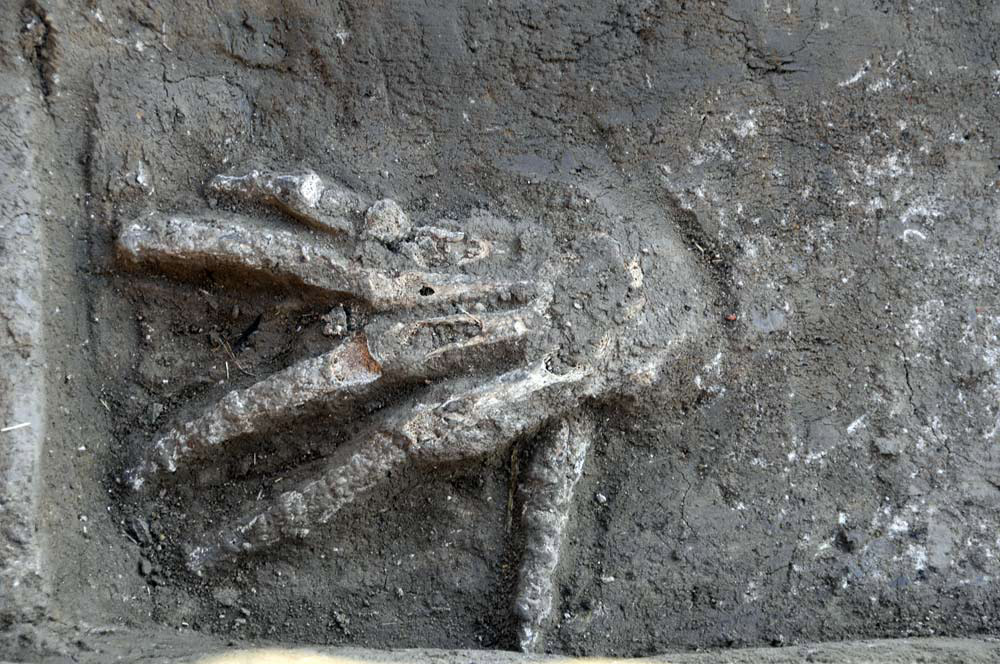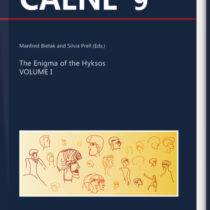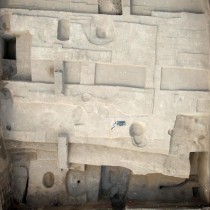For the first time, a group of severed human hands found at Avaris/Tell el-Dab‘a have been medically documented, shedding light on the character of one of ancient Egypt’s most gruesome wartime practices. The team of researchers involved in the study, headed by Julia Gresky and including Tell el-Dab‘a’s Director of Excavations Prof. Manfred Bietak, has published their findings in an open-access article in the journal Scientific Reports.
The group of hands had been found at Avaris/Tell el-Dab‘a, within a palace built by the Hyksos, the western Asians that controlled northern Egypt c.1640–1530 BC, ruling as the 15th Pharaonic Dynasty. In fact, the hands had been deposited in three pits within a courtyard in front of the palace’s throne room. As stated in the publication, stratigraphical evidence in the form of later offering pits and the filling of a well from the later phase shows that the palace may have been used until the late Hyksos Period.
Although this kind of practice is known through inscriptions and reliefs in Egyptian tombs and temples, this is the first time that physical evidence has been used to learn more about the procedure and the individuals whose hands were taken. Tomb inscriptions of prominent warriors, as well as inscriptions and images in temples, all dating from the start of the New Kingdom (18th–20th Dynasties) onwards testify on the recurring image of soldiers presenting the severed right hands of foes to the Pharaoh, in order to garner the “gold of honor”, a prestigious reward in the form of a collar of golden beads. In the absence of physical evidence, researchers had interpreted the practice both as punishment of defeated groups, as well as a ceremonial/ symbolic demonstration of bravery. In that light, the discovery of actual severed hands in Avaris, in a context slightly earlier than the earliest known literary evidence in 2011 was by itself a breakthrough. Now researchers could look at the origins of the practice, its meaning, its actual performance, and even the people involved in it!
Indeed, the team of researchers carried out taphonomic and biological analyses on the bones, revealing information regarding the act of mutilation and preparation of these body parts, as well as about the individuals to whom they originally belonged. Based on bioarchaeological evidence, a minimum of 12 eight hands can be detected, pointing to twelve individuals. Still, six single digits have also been found in two of the pits, raising the number of right hands, and the enemies mutilated, to a maximum of 18. The complete hands’ biological profile points to 11 male and possibly one female individuals, who may not have reached late adulthood. It is unclear if the hands were taken from dead or living individuals. It also seems that after preparation in order to remove any attached parts of the forearm, the hands were placed on the ground with wide-splayed fingers, mainly on their palmar sides. “The absence of the distal parts of the lower arm and the lack of cut marks indicate the hands underwent a careful pre-depositional preparation phase, aimed at removing all elements deemed to be unrelated to the anatomy of the hand”, the article states.
The osteological analysis not only supports the archaeological interpretation of this evidence but also adds more detail regarding trophy-taking practices in Ancient Egypt. While corporal mutilation of enemies has been known in Egypt since the time of King Narmer in the Early Dynastic period, the severing of hands appears in Egyptian records only after Hyksos rule and has a ceremonial character. This first depiction comes from Abydos, from the temple of Ahmose, the Egyptian pharaoh who defeated the Hyksos, conquering Avaris. It was there where Ahmose was probably exposed to the custom as a Hyksos practice and adopted it with his troops as a trophy-taking practice. About that time, a new hieroglyph appears to support the practice’s reporting in later times, also connected with a word of Semitic and not Egyptian origins. This shows a severed hand prepared exactly in the way seen in the physical remains in Avaris. Given the importance of completeness for an individual’s eternal survival according to the Egyptian worldview, dismembering an enemy enables their symbolic demise and an act of dominance against them. The connection of the practice with the ceremony of the gold of honor is addressed in the same context where the hand-mutilation hieroglyph is first attested; the autobiography of Ahmose son of Ibana, in this warrior’s tomb at El Kab.
Regarding the practice’s original character then, it only takes to see the Hyksos context in Avaris alone, as well as the area of the Near East, where the Hyksos came from. Indeed, rows of possible severed hands and heads, together with animal heads, appear in Middle Bronze Age Syrian glyptic art (seals). Also, the hands’ placement before Avaris’ throne room point to both a symbolic reinforcement of the king. Finally, as pointed out in the article’s conclusion, “when contextualized in a transdisciplinary approach to the archaeological and historic sources, the bioarchaeological evidence presented here suggests that the severed hands were offered as trophies as part of a public event that took place in the palace”. It is difficult to know whether the original Hyksos ceremony was identical to the awarding ceremony of the gold of honor, known from Egyptian sources. Still, it is pretty certain that the Egyptians adopted the Hyksos practice together with its meaning: the symbolic offering of an enemy’s power to the king by the army’s bravest.





